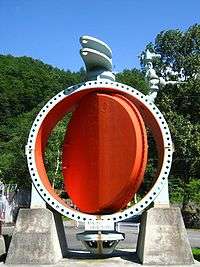Butterfly valve

A butterfly valve is a valve which can be used for isolating or regulating flow. The closing mechanism takes the form of a disk.
Principle of Operation
Operation is similar to that of a ball valve, which allows for quick shut off. Butterfly valves are generally favored because they are lower in cost to other valve designs as well as being lighter in weight, meaning less support is required. The disc is positioned in the center of the pipe; passing through the disc is a rod connected to an actuator on the outside of the valve. Rotating the actuator turns the disc either parallel or perpendicular to the flow. Unlike a ball valve, the disc is always present within the flow, so a pressure drop is always induced in the flow, regardless of valve position.
A butterfly valve is from a family of valves called quarter-turn valves. In operation, the valve is fully open or closed when the disc is rotated a quarter turn. The "butterfly" is a metal disc mounted on a rod. When the valve is closed, the disc is turned so that it completely blocks off the passageway. When the valve is fully open, the disc is rotated a quarter turn so that it allows an almost unrestricted passage of the fluid. The valve may also be opened incrementally to throttle flow.
There are different kinds of butterfly valves, each adapted for different pressures and different usage. The zero-offset butterfly valve, which uses the flexibility of rubber, has the lowest pressure rating. The high-performance double offset butterfly valve, used in slightly higher-pressure systems, is offset from the centre line of the disc seat and body seal (offset one), and the centre line of the bore (offset two). This creates a cam action during operation to lift the seat out of the seal resulting in less friction than is created in the zero offset design and decreases its tendency to wear. The valve best suited for high-pressure systems is the triple offset butterfly valve. In this valve the disc seat contact axis is offset, which acts to virtually eliminate sliding contact between disc and seat. In the case of triple offset valves the seat is made of metal so that it can be machined such as to achieve a bubble tight shut-off when in contact with the disc.
Types
- Concentric butterfly valves - this type of valve has a resilient rubber seat with a metal disc.
- Doubly-eccentric butterfly valves (high-performance butterfly valves or double-offset butterfly valves) - different type of materials is used for seat and disc.
- Triply-eccentric butterfly valves (triple-offset butterfly valves) - the seats are either laminated or solid metal seat design.
Triple-eccentric (offset) design
Triple eccentric (offset) Design prevents galling and scratches between the metal seat and the metal disc due to its unique design. The only time where the seal comes into contact with the seat is at the point of complete closure. Triple offset valves are generally used in applications which require bi-directional tight shut-off in oil and gas, LNG/NPG terminal and tanks, chemical factories, and shipbuilding. They are also used for dirty/heavy oil to prevent extrusion. Inventor of this design is the Adams company in Germany (patent 1960).
Wafer-style butterfly valves
The wafer style butterfly valve is designed to maintain a seal against bi-directional pressure differential to prevent any backflow in systems designed for unidirectional flow. It accomplishes this with a tightly fitting seal; i.e., gasket, o-ring, precision machined, and a flat valve face on the upstream and downstream sides of the valve.
Lug-style butterfly valve
Lug-style valves have threaded inserts at both sides of the valve body. This allows them to be installed into a system using two sets of bolts and no nuts. The valve is installed between two flanges using a separate set of bolts for each flange. This setup permits either side of the piping system to be disconnected without disturbing the other side.
A lug-style butterfly valve used in dead end service generally has a reduced pressure rating. For example, a lug-style butterfly valve mounted between two flanges has a 150 psi pressure rating. The same valve mounted with one flange, in dead end service, has a 75 psi rating. Lugged valves are extremely resistant to chemicals and solvents and can handle temperatures up to 200 °C which makes it a versatile solution.
Use in industry
In the pharmaceutical, chemical and food industry a butterfly valve is used to interrupt product flow (solid, liquid, gas) within the process. The valves used in these industries are usually manufactured according cGMP guidelines (current good manufacturing practise). Butterfly valves generally replaced ball valves in many industries particularly petroleum due to lower cost and ease of installation, but pipelines containing butterfly valves cannot be 'pigged' for cleaning.
Images
| Wikimedia Commons has media related to Butterfly valves. |
- Cast iron butterfly valve
 Cast iron butterfly valve
Cast iron butterfly valve Large butterfly valve
Large butterfly valve